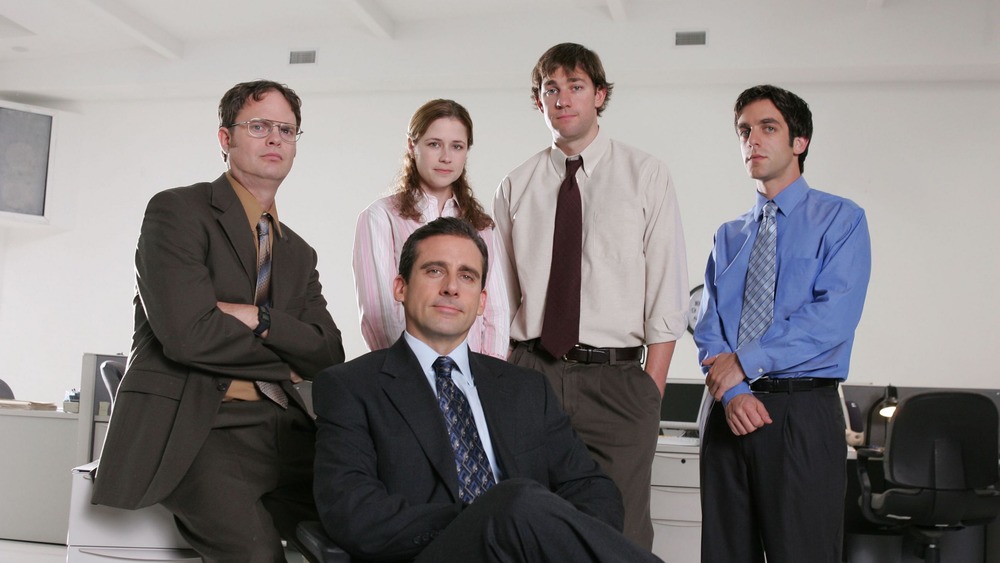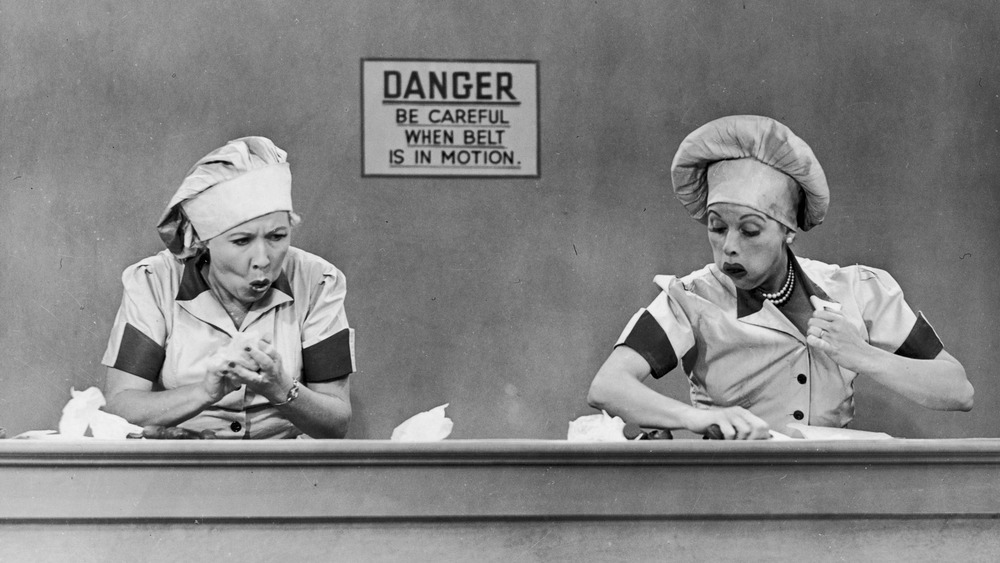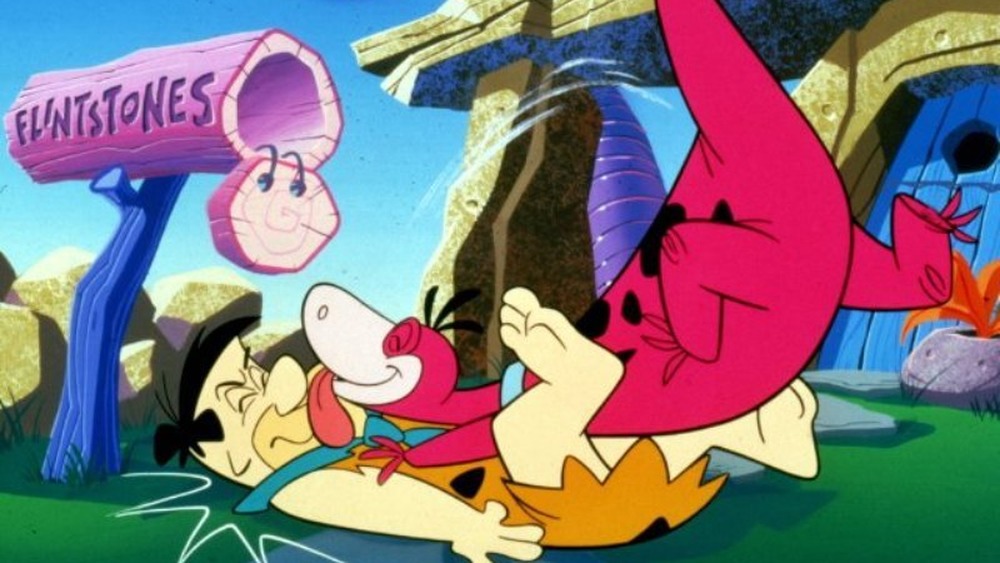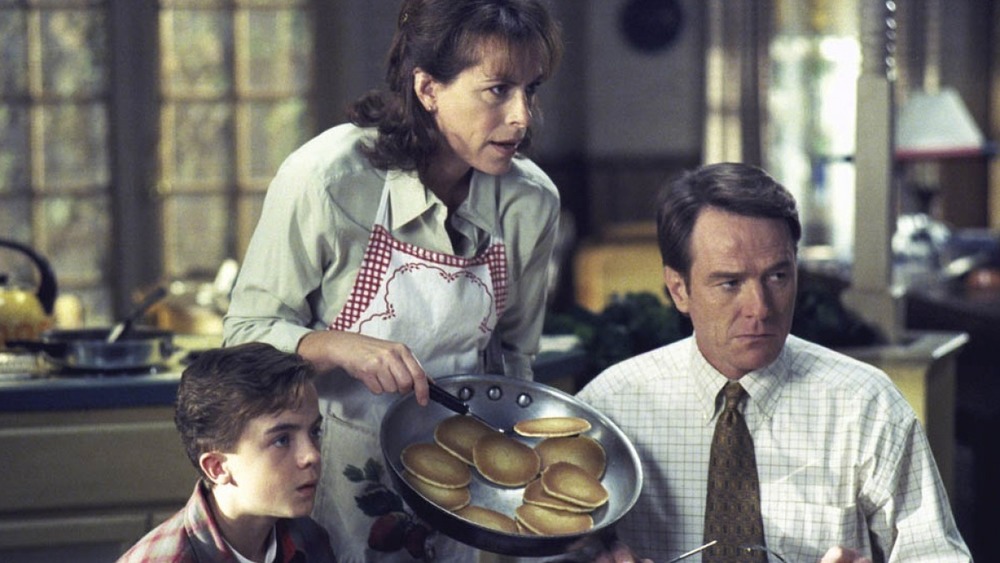The Real Reason TV Sitcoms Stopped Using Laugh Tracks
Once a staple of the American sitcom, the canned laughs of yesteryear have all but died out. Laugh tracks — or pre-recorded and sometimes even live audience laughter that once cued at-home viewers into a show's jokes — have largely gone extinct. In their place are an unmistakable silence and the expectation that audiences, whether they're watching on their phone, computer, or TV, will know a good joke when they hear it.
But how did something seemingly so pivotal to the TV sitcom experience essentially vanish? According to the CBC, the reason spans actual decades and ultimately illustrates how Hollywood television production has evolved, thanks to new technology and revolving network leadership. But before you can know where it went, you have to know where it starts — it loosely starts in the early 1950s' with an Emmy winning sound engineer by the name of Charles Douglass. The inventor of the Laff Box — an early iteration of the laugh track — Douglass was working at CBS network when he created a tool that could give a TV editor the ability to control a series of audiotape loops.
Taking a cue from radio producers who were the original pioneers of recorded laughter, Douglass channeled his frustration with live TV audiences who didn't laugh quite right into the creation of his device. To diminish the impact of live viewers laughing too long or too loud, laughing at the wrong time, or even not at all, the sound engineer crafted a usable library featuring hundreds of human sounds. The Los Angeles Times reported that these sounds were largely taken from dialogue-free sequences in The Red Skelton Show, a variety program. When the operator played the Laff Box, they could control the timing of an audience's murmurs, guffaws, and eventually, eruptions of laughter.
Initially, it was used to re-shoot scenes in 1950s TV shows to fill the sound holes that arose after the studio audience went home. But eventually, it became a tool to embellish live viewer's existing laughter on shows with live audiences and the main source of laughs for series without one.
Despite growing dislike among creatives, network executives heavily encouraged the use of laugh tracks
Douglass' version of the laugh track would make its debut in 1950 on The Hank McCune Show, but evidence of its success helped its use rapidly expand through the small screen industry. Some TV producers liked the technology for its ability to make screen-viewing a more "shared" or communal experience. For an American public used to live entertainment — and shared responses — watching from home could offer watchers a sense that they weren't laughing or reacting alone.
In a 1955 piece published in Billboard magazine, executive production Babe Unger underscored this. Despite hating "canned laugh tracks" himself, he and other executives thought "audience reaction is necessary... because TV viewers expect an audience to be there." Not to mention, the tracks also helped cover up when live audiences weren't finding the material funny, a reality that put TV comedies in an uncomfortable bind.
Despite many taking a liking to it, not everyone was receptive. In a separate interview conducted in 1955, actor and producer David Niven called the laugh track "the single greatest affront to public intelligence I know of," according to CBC.
The success of industry-changers like Lucille Ball and Desi Arnaz with I Love Lucy helped stave off an over-reliance on the laugh track for a bit — thanks to the iconic duo's invention, the multi-camera filming technique. This approach required several cameras instead of one to film, enabling the show to capture several different angles of the same scene at once. It was a technique perfected by shows like The Golden Girls. As the multi-camera comedy emerged, the reaction shot was allowed to flourish, altering the time live audiences had to react to a joke by literally extending the joke from the punchline to a character's reaction to the punchline, and sometimes a reaction to the reaction.
Still, the early contention around its use would find itself on the losing side of the battle over canned versus live laughter for several more decades.
Laugh tracks permeated across genres from war comedy's like M*A*S*H to animated series like The Flintstones
While there were other ways to get laughs, TV producers of the 60s and 70s found themselves leaning increasingly into recorded laughter, even on animated series like The Flintstones and The Jetsons. According to Tim Brooks, co-author of The Complete Directory of Prime-Time Network and Cable TV Shows, those two decades saw a medium "renowned for excess" largely "unable to constrain itself." "...Some producers went crazy with laugh tracks and turned them higher and higher" in the hopes that at-home viewers would find the comedy funnier "even when it wasn't," he told the LA Times.
But the return to an increased reliance on the laugh track wasn't only due to overzealous network executives. Instead, developments in the production process somewhat forced editors to put it to more frequent use. When TV began its shift from live broadcasts to videotaped airings, a new editing approach created an issue — a live audience's recorded laughter could abruptly interrupt the cutting process. To smooth it out, TV series used versions of the laugh track. This carried beyond American television production as well. The CBC reported that while all of BBC's comedies featured laugh tracks, a version of The Hitchhiker's Guide to the Galaxy from 1981 featured a track to appease network executives — though it was dropped before broadcast.
Ultimately, the laugh-track success of series like Bewitched, The Andy Griffith Show, and even The Muppets would force other, more topically serious or complex comedies like All in the Family or *M*A*S*H to utilize them, too. The army comedy's co-creator Larry Gelbart was among those who fought to work without a laugh track, but the CBC reports he was only able to get it removed during medical scenes due to insistent CBS executives.
Despite its prevalence, it was still considered by a significant chunk of the TV community as the "bane of certain elements of the creative community for many years" with many feeling "that it degrades its art somehow," Tim Brooks explained to the LA Times in 2003.
International productions and the emergence of cringe comedy helped usher in a new era
Nowadays, you barely hear a single laugh track. In 2016, only three of the new U.S. broadcast network half-hour comedies airing in the fall featured them. Those series, The Great Indoors, Kevin Can Wait, and Man With a Plan, all aired on CBS. So what happened for TV to shift away from the laugh track? A few things, including the international community's rejection of the tool. Some Latin American productions avoided using recorded laughter and instead hired professional laughers who filled the comedic silence. Mexican and Canadian productions balked at using the tracks, sometimes only adding them if their series were sold to a U.S. broadcaster.
That helped the growing movement of American creatives, who had been told that research supported laugh tracks for years. Bob Douglass, the son of the Laff Box creator, told the LA Times that the device not only helped the pacing of comedy series, but that, "They actually tested sitcoms during one night, two or three with the laugh track and one without, and the one without didn't do as well because people come to expect it. There was a feeling that something was missing."
A 1974 study found that jokes followed by laugh tracks increased ”conformity pressure" in test subjects, suggesting that we laugh along to fit in. The laugh track, then, somewhat prays on this (via The New York Times). But more recent findings that pinned the laugh-tracked Seinfeld against longer-running animated comedy The Simpsons found there wasn't much of a difference in how viewers responded to the show without canned laughter, according to Science News.
The rise of the cringe comedy genre in the 1990s and 2000s also helped creatives make a more solid case for in-studio silence and at-home laughs. Beginning with the success of series like the U.K.'s The Office, American comedies like NBC's 30 Rock and The Office, Netflix's Arrested Development, FOX's Malcolm in the Middle, and Bernie Mac passed on the canned laughs. Still, they found success, encouraging a whole new generation of TV shows to put a lid on their recorded laughs.



